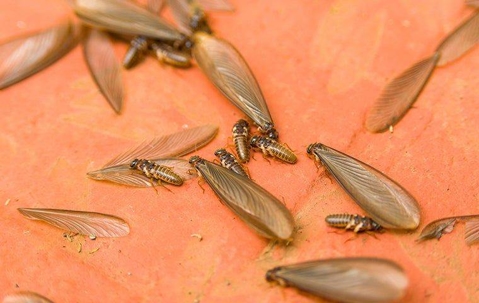Flying Ant vs Termite: How to Tell the Difference in West Palm Beach, FL
Have you noticed flying insects swarming around your home and wondered if they’re flying ants or termites?
While they may look similar at first glance, telling them apart is essential for protecting your home from structural damage. Florida homeowners frequently deal with ant infestations, but termites pose a much greater threat.
Knowing the differences can help you take the right steps toward pest control.
Key Takeaways
- Both flying ants and termites fly to start new colonies, but they have different body shapes, wings, and antennae.
- Flying ants have bent antennae, a pinched waist, and uneven wings, while termites have straight antennae, a straight waist, and equal wings.
- Flying ants live in crevices and eat sugars and proteins, while termites nest in wood and cause serious damage.
- Pest control services help remove ants and termites with treatments that stop infestations and prevent them from coming back.
Flying Ants vs. Termites: Key Differences
.2503080631268.webp)
Both winged ants and winged termites (also called swarmers or alates) take flight during their nuptial flight to establish new colonies. However, certain behaviors and physical characteristics can help you tell them apart:
Features | Flying Ants | Termites |
Antennae | Elbowed (bent) antennae | Straight antennae, no bends |
Waist Shape | Pinched waist, segmented body | Straight-waisted, no separation |
Wings | Front wings longer than hind wings | Equal-sized wings, extend past the body |
Nesting Sites | Crevices, door frames, baseboards, and crawl spaces | Underground, basements, attics, and furniture |
Feeding Habits | Sugars and proteins | Wood, drywall, and furniture |
Swarm Season | Warm months, often after rain | Early spring, usually after rainfall |
How to Prevent an Infestation
If You Have Flying Ants
If you have flying ants, including Florida carpenter ants or fire ants, start by sealing entry points around door frames, baseboards, and windows.
Remove food sources like crumbs and open containers to avoid an ant problem, and use baits to target the ant colony. Fix moisture problems, as worker ants—especially Florida carpenter ants—are drawn to damp areas.
While DIY ant control may help, professional treatment ensures long-term results.
If You Have Termites
If you have termites, look for signs of termites like mud tubes, hollow wood, and discarded wings. Subterranean termites are especially destructive since they tunnel from the soil into wooden structures.
To prevent damage, schedule a free quote for a termite control inspection and fix any water sources that attract termites.
Call a Pest Control Company in West Palm Beach
If you’re unsure whether you have flying ants or termites, don’t wait until the damage is done. At Native Pest Management, we offer the following ant and termite control services to protect your home:
For Ant Problems
We use pet-friendly baits and non-repellent treatments to eliminate carpenter ants, fire ants, and other species of ants at the source. Our entry point sealing and ongoing pest control services ensure they don’t come back.
For Termites
We provide subterranean termite baiting systems, liquid barrier treatments, and drywood termite fumigation to stop infestations and prevent further structural damage.
Contact us today, and let our exterminators take care of your pest issues with solutions in West Palm Beach!
